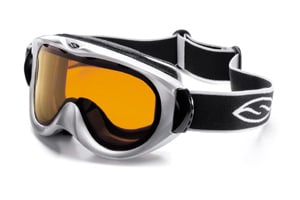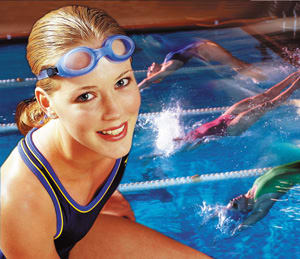How
I...
Put Safety first: Kids' Sport Goggles
By Marcy Bruch
The statistics speak for themselves. According to a Prevent Blindness America study in 2001, more than 38,000 people experienced a sports-related eye injury and needed some kind of medical treatment. What's more, most of those eye injuries occurred in children ranging in age from five to 14. School-age children are particularly prone to eye injuries since their hand-eye coordination, balance, reaction time, and speed are still being developed. But regardless of age, 90 percent of sports-related injuries could be
prevented if an athlete simply donned protective sports eyewear.
|
|
|
|
Smith's Grommet PMX goggles are designed for kids ages six and up |
|
Paul Berman, OD, who has a namesake practice in Hackensack, N.J., has become an expert in this area, since he is former chair of the Sports Vision Section of American Optometric Association, and was named Sports Vision Optometrist of the Year in 2000. He has been an eye safety consultant for a variety of Olympic teams, as well as the New York Giants, the New Jersey Nets, and the New Jersey Devils. He offers a wide variety of safety sport goggles at his dispensary, which retail anywhere from $110 to $140, and most of those sales come from kids' goggles.
Baseball and paintball have the highest incidents of eye injuries followed by football, and soccer, and last but not least, swimming. "Parents make the mistake of thinking that a helmet or faceguard is enough protection for eyewear injuries," Berman says. "But a child is still exposed to danger from sports equipment or an opponent's fingers penetrating the openings of a facemask."
Lenses in kids' prescription eyewear or plano sunwear can also pop out and puncture the eye, or a mangled frame may injure the ocular region of the face, which is why most sport goggles are
Rxable. "All parents have to do to keep their child from becoming the next eyewear injury statistic is to make sure
protective sport goggles are in their kids' equipment bags," Berman says.
EDUCATING PARENTS
Sounds easy enough, but the question is: How do you educate parents about the importance of sport goggles as a safety measure against children's eye injuries? Kathy Johnson, an optician for Little Lenses in Minnetonka, Minn., printed up a fact sheet utilizing the Prevent Blindness statistics and taped it onto a display case which houses kids' sport goggles.
"Our office is in a pediatric medical building where there's nothing but doctors who specialize in children's medical needs. So we have a display case outside in the main corridor where there's plenty of foot traffic. That's where we display all our children's sport goggles. We've gotten a lot of business from parents who just walk in after reading the fact sheet inside the display unit," she says.
|
|
|
|
For swimming, protective eyewear serves several purposes. Above, Rec Specs swim goggles from Liberty Optical |
Safety-tip brochures from sport goggle manufacturers are also useful tools. Chris Kiniuk, an optician for Kids Specs in Morristown, N.J., passes them out to every parent who walks through her dispensary's doors. In addition, if there's a newspaper article covering an athlete who had an eye-injury accident, Kiniuk photocopies the article and hands it out to parents as an educational tool.
This eye-injury awareness campaign has paid off, since Kiniuk can't keep her kids' sport goggles in stock. "I've had two incidents where kids have reported that they've gotten hit hard square in the middle of their goggles by a ball. Half an hour later, when they take them off their face and place them into their equipment bags, they will find the goggles have broken in two, which is what they are supposed to do. Sport goggles absorb the shock while on the face, and break when they are safely off the face."
PACKAGE DEALS
Since kid's prescription sport goggles can be pricey--averaging around $165 for frames and lenses--many dispensers offer package deals for a pair of ophthalmic frames and sport goggles. "I often give parents 10 percent off a pair of sport goggles whenever they are buying their kids prescription frames," says Kiniuk. "And because they are safety-related, sport goggles are often covered under insurance plans, too, so they can include them as part of their cash allotment."
Unfortunately, some dispensers say sales spike right after one child on a team experiences an eye injury. "We had a girl come in here for safety goggles because she broke her eye socket playing lacrosse. Shortly thereafter, 12 other girls from her lacrosse team came in with their parents requesting the same goggles, which retailed for $80 a piece," says Shannen Knight, owner of Sight for Sport Eyes in Portland, Ore.
UPGRADE LENSES
To take some the bite out of the high price, Johnson of Little Lenses finds out if kids are involved in sport activities year-round. If they are, she will offer prescription goggles with photochromic lenses, enabling children to get more use out of them. "Parents may be paying $65 to $75 more for the lenses, but they can justify the cost because the goggles now protect their kids' eyes for virtually any sporting activity while seeing more clearly. They feel like they are getting more bang for the buck."
|
|
|
|
Vantage modular swim goggle from Hilco is one of the firm's safety offerings for kids |
|
One of the reasons sport goggles makes up 10 percent of Little Lenses' business is because the pediatric optometrist on staff recommends them to every child who is involved in sports.
The same goes for Knight at Sight for Sport Eyes, where kids' sport goggles have been sold for the past seven years. "The first two years we offered them, the category grew by about 400 percent. Now it's leveled off to about a 15 to 20 percent growth rate per year," says Knight.
Her advice to other dispensers? "With consistent doctor recommendation, patient education, and a strong display presentation, you'll lay a strong foundation to continue building this
category of your business ."
|
SPORT GOGGLE PROFIT BOOSTERS |
Doctor recommendation. If the optometrist on staff automatically recommends that kids wear sport goggles for safety when they are engaged in sports, it makes selling that much easier. Educate parents. Utilize powerful statistics like those from Prevent Blindness America and create a countercard with information to place next to your goggle Offer bundled eyewear packages. Give parents a discount on sport goggles if they are buying them along with prescription eyewear. Let them know that that their insurance companies may cover part, if not all, of the sport goggle cost. Upgrade with lenses for year-round use. If children are involved in sports year-round, and they require prescription goggles, offer photochromic lenses so that they will be able to wear the goggles indoors or outdoors for a variety of different sporting activities. Display prominently. The only way to win at it is to make sure everyone knows you're in it, so display those goggles front and center. A rotary glass case placed in a store window would get the message across. |






